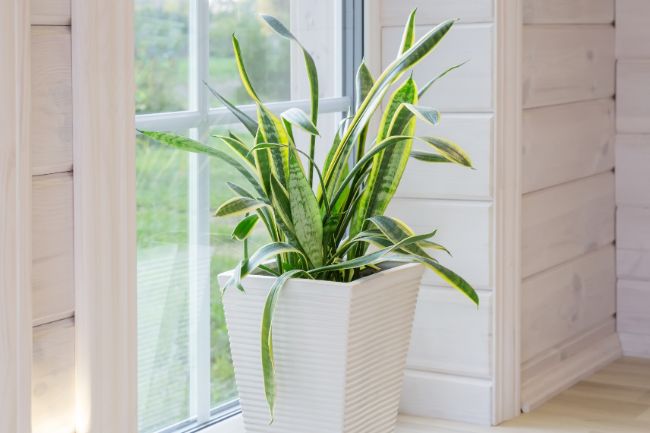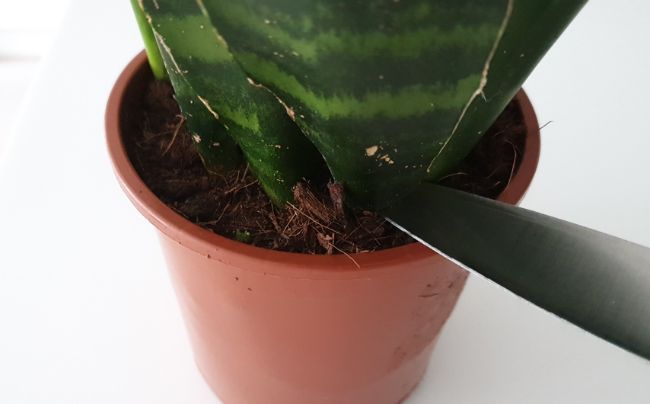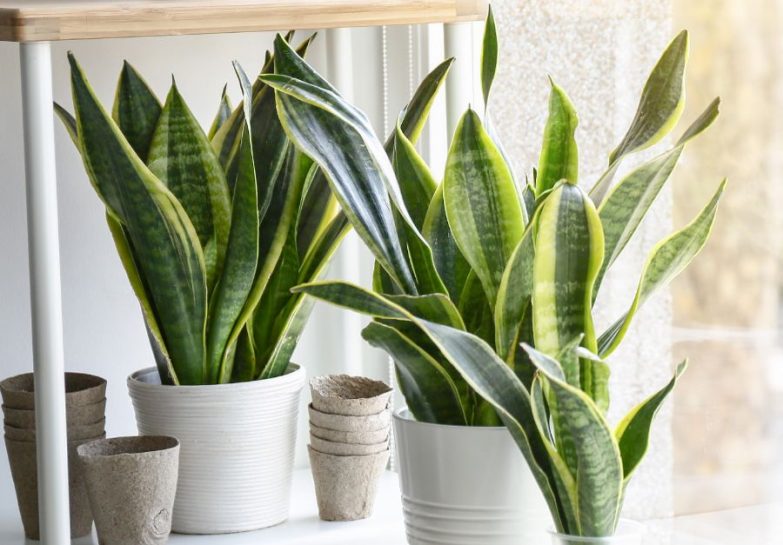Snake plants can grow to an impressive height of well over 4 feet tall if you let them, and the plant will spread outwards as new leaves sprout up from the rhizome below the soil. At some point, you may have to tidy things up, and it’s important to know how to prune a snake plant correctly, to keep your plant in good health and looking well.
How to prune a snake plant: Inspect the plant for signs of damage or poor health. Prune to restore shape, reduce size and improve the appearance of your snake plant. Use a sharp, sterile pair of pruners or a sharp knife to cut chosen leaves off at the soil line. Remove damaged and mature leaves in preference to new foliage.
When To Prune A Snake Plant
Snake plants are notoriously hardy and quite slow growing, so will likely tolerate pruning very well at any time of year. However, to give your plant the best chance of thriving after pruning, it is best to do this when the plant is actively growing, ideally in spring or early summer.
Pruning does put a snake plant under stress, so if your snake plant is in poor health, it is better to improve general care measures first, encourage some new healthy growth, and then prune your snake plant, to promote rapid recovery.
Why Should You Prune Your Snake Plant?
Snake plants don’t need pruned as often as some plants, but there are three main reasons why you should prune yours from time to time;
Maintain The Size Of Your Snake Plant
Snake plants increase in size by spreading out from a rhizome under the soil. New leaves will progressively enlarge the spread of the plant, and you will soon find that it completely fills the container it is in. This can lead to your plant becoming root bound, which will impact the health and stunt the growth of your snake plant.
Snake plant roots can be quite substantial in comparison to the size of the plant as a whole. A plant that looks reasonably comfortable in its pot can have roots that are tightly wound round the inside of the pot.
If you want to maintain the size of your plant, without having to repot it into a larger pot, then regular pruning is an important thing to do.
In addition, the leaves of a snake plant continue to increase in height for quite some time, and a plant that is relatively small when purchased, can soon have leaves that are several feet tall. One way to counter this is to prune off the tallest leaves. This helps to maintain a more moderate height.

To Remove Damaged Or Old Foliage
The leaves of a snake plant are such an interesting feature, and individual leaves can last for years. However, any damage that develops on them stays on the leaves permanently. Minor lapses in care, such as excessive sun, overwatering or a pest infestation can lead to damaged leaves that start to look unsightly after a while.
Thankfully, you can restore the good looks of your snake plant by pruning off any leaves that are starting to look a little unsightly, and new, perfectly formed leaves will soon sprout up to replace them, providing you look after your snake plant well.
To Improve The Shape Of Your Plant
Although snake plants have a reputation of being hard to kill, they are relatively challenging to keep in perfect condition. The leaves have a tendency to curl, droop or bend in a variety of directions, which can impact the look of your plant.
If your snake plant starts to look like the leaves are all doing there own thing, pruning is a great opportunity to tidy it up, restore some symmetry, and quickly fix a variety of issues quickly and easily.
Read my article about why snake plants get curled leaves for more info and to learn how to prevent this issue.
What Equipment Do I Need
Thankfully, very little. Here’s what I use to make the process as simple as possible.
A sharp knife, pruners or scissors. I usually get both a knife and a pair of scissors or pruners ready for this job, as the knife helps me cut the leaves off right at the soil line, and the scissors or pruners are easier to prune leaves in the central portion of the plant.
Use rubbing alcohol or boiling water to sterilize your tools, even if they look cosmetically clean. Your tools should be sterile, as it is very easy to spread disease from one plant to the next when pruning your houseplants.
Choose a clean surface with plenty of space to prune your snake plant. Pruning can be a little messy, as you will probably disrupt some of the soil, and you will also be left with plenty of cut leaves at the end. A clean bench or kitchen counter will do fine, but put down a few sheets of newspaper if you are pruning your snake pant on any surface that could stain or get damaged.
How To Prune A Snake Plant
Pruning a snake plant is a fairly easy process. Start by inspecting your plant to check the health, shape and size. Think about what shape and size you would like your snake plant to be at the end of the process. This will help you target which leaves to prune.
I normally follow these three steps to prune a snake plant;
Reduce The Spread Of Your Snake Plant
Start by pruning the leaves around the edge of the plant, assuming you wish to reduce the size of the plant by pruning, rather than just remove damaged leaves. Use a sharp knife to cut each leaf off as close to the soil line as possible. Removing the leaf as close to the base will improve the cosmetic appearance of your snake plant. Stubby leaf stumps do not generally look great, so it is worth the extra effort to cut the leaves off as low down as possible.
The best way to do this is to hold the top of the leaf, apply a little upward pressure, hold your knife parallel with the soil and make a single horizontal cut across the leaf.
Snake plant leaves can be quite tough, so it may take a little effort to cut through each. Try to make a clean cut, rather than a series of jagged cuts. A ragged leaf edge can increase the risk of disease entering the cut leaf stump.

Reduce The Height Of Your Snake Plant
Once you have removed the outer leaves to your satisfaction, concentrate on the height of the plant. Target each leaf that is taller than you wish the plant to be and cut each off the plant.
For leaves in the interior of the plant, you will find using pruners or scissors easier than a knife, but it is harder to cut the leaf off right at the base. Don’t worry about this, as no one will see the leaf stumps in the interior of the plant, so your plant will still look beautiful.
Remove Damaged Leaves
Once you have trimmed your snake plant down to the required size, identify any damaged or deformed leaves that you wish to prune to improve the cosmetic appearance of your plant. Ensure that removing these will not leave your plant looking lopsided or sparse. It’s OK to have a houseplant that doesn’t look perfect, so don’t fret about removing every single leaf with a tiny imperfection.
When pruning your snake plant, try not to reduce the size of the plant by more than one third at a time. Pruning is a stressful experience for your snake plant, and pruning back too much can leave it vulnerable to disease or it may just struggle for some months after pruning if you go too far.
Another thing I would advise against is pruning parts of leaves. It is very tempting to cut off brown tips and leave the rest of the leaves, but this doesn’t tend to be effective, as the cut end often becomes brown itself, and it does increase the risk of disease for the plant.
How Often Do I Need To Prune My Snake Plant
Assuming you cut your snake plant back by one third or less, you can expect your snake plant to need pruned again in 2-3 years. Snake plants don’t grow particularly quickly, and it will depend on the conditions you are growing your plant in. Many people grow snake plants in lower light conditions indoors, which will slow their growth down significantly.
There are no hard and fast rules about how often to prune your snake plant. In fact, if you wish to let your snake plant grow to its full potential, you can repot it into a larger pot as it grows and, as long as the plant looks well to you, you need not prune it at all.
Can I Grow New Snake Plants From The Cuttings?
Absolutely. Snake plants are very easy to propagate in soil or water from leaf cuttings. It does take a bit of time, but is really easy. Read my article on propagating snake plant cuttings for more info. This is a great opportunity to grow a few extra snake plants for your home or to share with your friends and family.
If you’ve found this article helpful, you may like to read my other snake plant care articles for further information.

